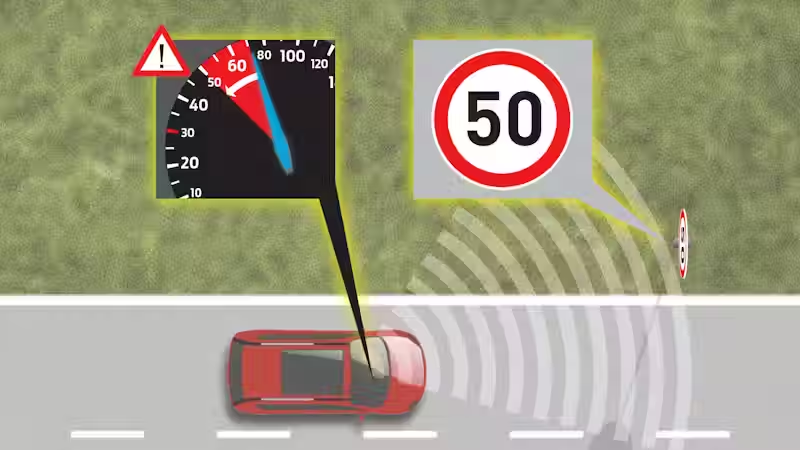It’s no secret that driving in the UAE is about to change—especially for those of us managing fleets. Starting in 2025, new speed limiter regulations are coming into effect, and if you operate commercial vehicles, this affects you directly.
These aren’t just small tweaks. The new laws will shape how we control vehicle speeds, enforce driver behavior, and use technology to stay compliant. Let’s break it all down.
✅Key Takeaway:
Starting in 2025, the UAE requires certain commercial and heavy vehicles to use approved speed limiting systems to boost road safety and reduce accidents. Fleet operators can stay compliant by adopting smart, GPS-based limiters that automatically adjust to road conditions and speed zones. These solutions not only meet legal requirements but also help manage driver behavior and operational efficiency—all while avoiding costly penalties and disruptions.
What Are the UAE Speed Limiter Rules for 2025?

Starting in 2025, the UAE will require certain commercial and heavy vehicles to use speed limiting systems that go beyond basic mechanical caps. These smart limiters adjust speed in real time based on location, road type, and traffic zones. Powered by GPS and connected data, they help prevent speeding violations without relying on driver judgment. The law targets trucks, buses, and fleet vehicles, and enforcement will include inspections, digital tracking, and potential penalties for non-compliance.
Who Must Comply?
The regulation applies to:
- Heavy Goods Vehicles (HGVs) over 3.5 tons
- Commercial buses and passenger vans with seating capacity above a certain threshold
- School transport vehicles
- Logistics and courier fleets, including e-commerce delivery vans
- Construction and waste management trucks
Private vehicles, motorcycles, and certain emergency or government vehicles may be excluded, but full exemption lists are expected to be published by the Emirates Authority for Standardization and Metrology (ESMA) or the RTA.
What Do These Rules Require?
By Q3 2025, all affected vehicles must have:
- Certified speed limiter systems installed
- The ability to restrict top speed based on national guidelines (usually capped at 100–120 km/h depending on vehicle type)
- Tamper-proof integration with the vehicle’s ECU or OBD system
- Optional but encouraged: integration with GPS-based dynamic speed control and telematics platforms
The regulations are not limited to basic mechanical limiters. The UAE government is prioritizing smart limiters—devices that use real-time GPS data, digital maps, and AI algorithms to adjust vehicle speed depending on:
- Road type (urban, rural, highway)
- Speed zones (including temporary construction limits)
- Time of day (e.g., school zones in morning/afternoon)
From Passive Devices to Smart Compliance
This isn’t just a checkbox regulation. The idea is to make vehicles “context-aware” using connected technologies. Instead of just blocking a vehicle from crossing 100 km/h, smart speed limiters use:
- Geofencing to apply zone-based limits
- Cloud connectivity for remote updates
- Telematics dashboards for fleet operators to review compliance, speeding events, and risk profiles
These features align with the UAE’s broader push for Intelligent Speed Assistance (ISA), which is already part of vehicle standards in Europe. The UAE version incorporates additional local elements like desert road limits, industrial zones, and school routes.
Compliance Deadlines and Enforcement
The UAE government isn’t leaving much wiggle room. As of July 2025, all eligible commercial and heavy vehicles must be equipped with officially approved speed limiting technology. This isn’t just a recommendation—it’s a mandatory legal requirement under revised traffic safety regulations introduced by the Ministry of Interior in collaboration with the RTA (Roads and Transport Authority).
The affected categories include:
- Commercial delivery vans and trucks
- Passenger transport buses
- School transport vehicles
- Public and private logistics fleets
- Vehicles over 3.5 tons gross weight (GVW)
These vehicles must have active, tamper-proof speed limiters installed—preferably connected systems that align with UAE’s push toward smart fleet regulation.
How Enforcement Will Work
Compliance isn’t just about installing a device and calling it a day. Enforcement will be layered, digital, and continuous:
- RTA Smart Platforms
Fleet data will sync with RTA’s central monitoring systems, powered by connected vehicle infrastructure. This will allow authorities to verify limiter activation status remotely.
- Vehicle Testing & Registration
During your annual vehicle inspection (like the Tasjeel process), inspectors will check:
- If the limiter is present
- If it is functional and properly calibrated
- Whether it logs speed data consistently
- If the limiter is present
- On-Road Surveillance
Real-time enforcement will happen via:
- ANPR (Automatic Number Plate Recognition) systems
- Smart speed cameras that flag vehicles exceeding preset limits
- Mobile enforcement units conducting random roadside compliance checks
- ANPR (Automatic Number Plate Recognition) systems
- Cloud-Based Data Matching
Non-compliant vehicles may be flagged automatically if their speed data (from connected GPS systems) shows a pattern of violations. This is part of the Digital Traffic Management System being scaled across major highways and urban zones.
Penalties for Non-Compliance
Failing to comply won’t go unnoticed—or unpunished. Penalties include:
- Hefty fines (expected to range from AED 3,000 to AED 10,000 depending on vehicle type and violation severity)
- Black points added to the driver or operator’s traffic file
- Suspension or cancellation of vehicle registration
- Fleet immobilization or blacklisting for repeat offenders
In serious cases, companies may even lose their commercial transport permits, severely impacting operations.
Final Note on Enforcement
Don’t assume this will be a “soft rollout.” The UAE is known for high compliance expectations, especially when it comes to public safety. By linking enforcement with digitized road monitoring systems, authorities are making this nearly impossible to bypass.
Early preparation is more than smart—it’s essential. Now’s the time to audit your fleet, upgrade your telematics, and get compliant before mid-2025 rolls around.
Why This Regulation Exists: Safety and Sustainability Goals
Let’s be honest—speeding is a major issue on UAE roads. According to the Ministry’s stats, a large portion of traffic deaths involve vehicles going over the limit.
By enforcing speed caps, the goal is to:
- Cut fatal accidents
- Reduce emissions
- Lower fleet fuel consumption
- Support Vision 2030 smart mobility goals
This shift also ties in with global trends. The Intelligent Speed Assistance (ISA) system is already mandatory in new vehicles across Europe. UAE is following suit—but going a step further with regional adaptations.
Compliance Options: Traditional vs. Smart Systems
Here’s the tricky part. Not all speed limiters are equal.
Traditional mechanical limiters are fixed. Once set, they cap speed regardless of road conditions. But they’re clunky, hard to reprogram, and don’t consider dynamic speed zones.
Enter smart GPS-based limiters. These work with:
- Real-time location data
- Telematics
- Fleet management platforms
They adjust vehicle speed dynamically. If a driver enters a 60 km/h zone, the system adapts. Hit a 100 km/h highway, and the limiter shifts accordingly. All without needing manual input.
How Smart GPS-Based Compliance Works
Think of it as speed control with a brain.
GPS-based systems tap into maps, geofencing data, and speed limits from RTA’s live databases. Combined with telematics and AI, they:
- Set and adjust speed limits automatically
- Alert drivers when they’re approaching restricted areas
- Create compliance logs for audits
In some setups, the system even slows the vehicle if the driver ignores a warning.
Solutions from companies like Resolute Dynamics are already active in thousands of vehicles across the UAE, India, and Southeast Asia. Their platforms blend AI-powered ADAS, driver behavior monitoring, and intelligent control systems—basically a full command center on wheels.
Choosing the Right Solution
Now comes the big question: how do you pick the right tech?
Look at:
- Fleet size and daily mileage
- Road types your vehicles travel (urban vs. long-haul highways)
- Driver training and turnover
- Existing telematics setup
You want something that integrates easily, avoids downtime, and gives you clear dashboards. Real-time analytics are crucial—not just for safety, but for operational control.
Look for features like:
- Over-speed alerts
- Behavior scoring
- Remote system updates
- Compliance reports
Resolute Dynamics: Built for the 2025 Challenge
If you haven’t heard of Resolute Dynamics, now’s the time. They’ve been rolling out smart fleet tech long before these regulations hit the table.
Their systems:
- Use AI to detect risky behavior
- Monitor speed, lane discipline, and fatigue
- Integrate GPS for real-time limiter enforcement
- Offer cloud-based dashboards for compliance teams
With over 200,000 connected vehicles globally, including fleets right here in Ras Al Khor, they’re not testing. They’re delivering.
How to Get Started: Compliance Checklist for UAE Fleet Operators

Here’s your roadmap to stay ahead of the law:
- Audit your fleet – Identify vehicles that need limiters
- Talk to your vendor – Ask if your current telematics can integrate speed control
- Set a timeline – Don’t wait till Q3 2025
- Train drivers – Explain how the new system works
- Run a pilot – Start with 10 vehicles, get feedback
- Go live – Roll out fleetwide and sync with RTA systems
- Log compliance – Document every step. You may need it.
FAQs
Do all vehicles need speed limiters?
Only certain vehicle types—mainly commercial and heavy-duty fleets. Check with RTA for a full list.
Can GPS limiters be overridden?
Most systems allow admin-level override for emergencies but log every instance.
Will this slow down operations?
Only if drivers are used to speeding. Smart systems keep you legal and efficient.
Is this the same as ISA?
ISA is part of it, but the UAE version includes regional enhancements and fleet-level control.
Final Thoughts
These new rules aren’t just about obeying the law—they’re about making roads safer and fleets smarter.
Start planning now. Don’t wait until inspectors are at your door. Smart speed compliance isn’t just the future—it’s already here.
